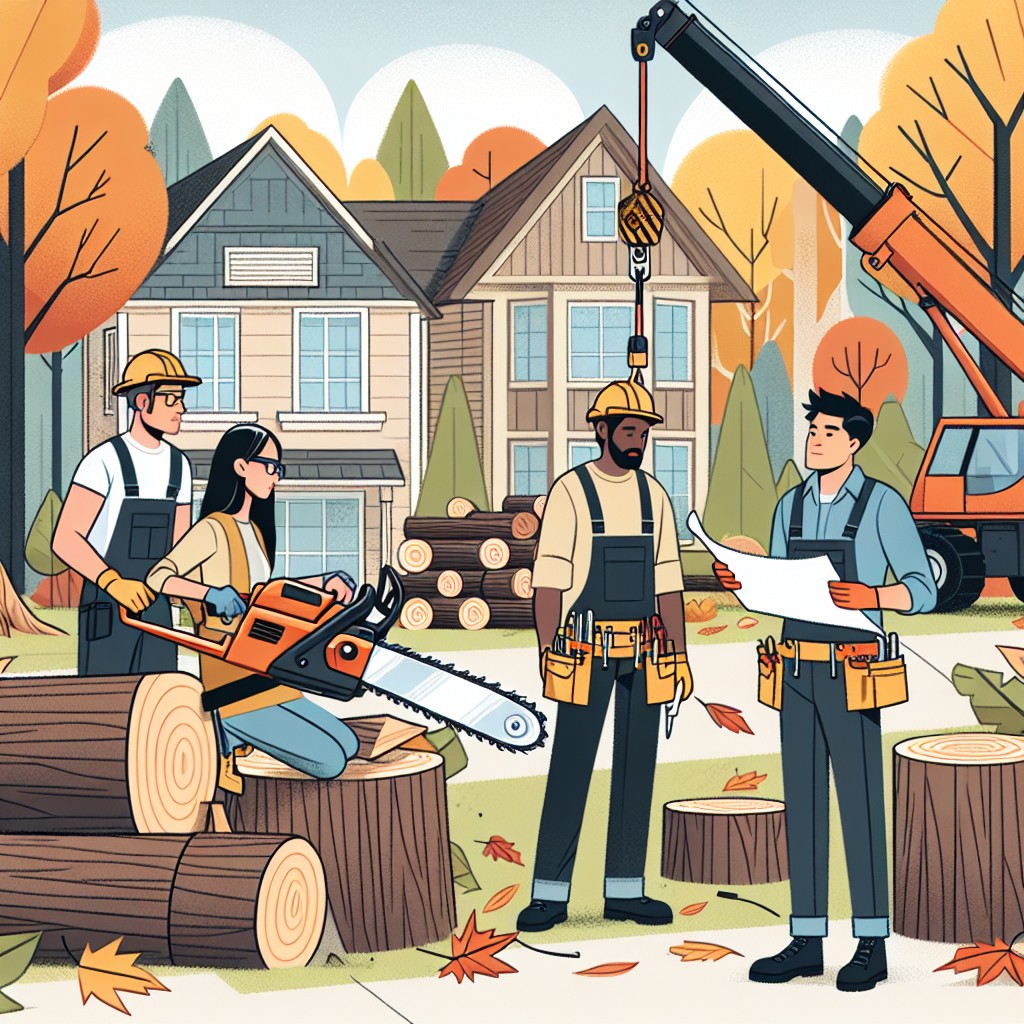Last updated on
Embrace significant savings without compromising your landscape’s appeal because the cheapest time of year for tree removal is just around the corner and ready to be uncovered.
Strategically timing the removal of a troublesome tree can lead to substantial savings and reduced hassle, much like catching the perfect window for off-season travel deals. As the crisp air of autumn fades and the stark chill of winter takes hold, tree removal services often lower their prices, providing an opportunity for budget-conscious homeowners.
Conversely, the busy hum of spring and summer comes with increased demand and costs for such services. Navigating the elemental influences on arboreal care, you might uncover off-season discounts and promotions. Meanwhile, ensuring the job is done safely and proficiently underscores the necessity of enlisting professional arborists regardless of the season.
In the following paragraphs, you’ll discover how to capitalize on the most cost-effective times for tree removal and why weather conditions play a pivotal role, empowering you to make an informed decision that protects both your wallet and your property.
Key takeaways:
- Winter and fall are the cheapest seasons for tree removal.
- Summer and spring are the peak seasons with higher prices.
- Weather conditions can affect tree removal rates.
- Off-season discounts from tree removal services are available.
- Hiring professional arborists is important for safety and quality.
Factors Determining Tree Removal Costs

Several variables influence the overall expense of removing a tree. The tree’s size is a key determinant—the taller and wider it is, the more work is involved in its safe removal, which increases labor costs. Accessibility also plays a role; trees that are easy to reach are typically less expensive to remove compared to those near buildings or power lines that require special attention and equipment. The tree’s condition is important, too; a diseased or rotting tree might complicate the removal process, potentially bumping up the price. Lastly, local regulations may require permits for tree removal, which can add to the final cost. Understanding these factors provides clarity when you receive a quote from a professional.
Winter: The Prime Season for Affordable Tree Removal

Dormant branches and less foliage during winter create an optimal condition for arborists to work swiftly, which can result in lower prices for tree removal. Additionally, the slower business season encourages companies to offer competitive rates to attract customers. With ground frozen, there’s less risk of damage to the surrounding landscape, further reducing potential extra costs for repair.
It’s also a period of preparation where removing potentially hazardous trees can be managed before spring growth and stormy seasons commence. Affordable winter rates don’t translate to lower quality; professional arborists are still utilizing the same expertise and equipment, they’re simply working under more favorable conditions which can benefit your wallet.
Fall: A Cost-effective Alternative for Tree Care

As leaves begin to tumble, so too can the cost of tree removal. During fall, the demand for arborists drops, leading to more competitive pricing for homeowners.
With the foliage thinning out, it’s easier for professionals to assess the health and structure of trees, providing accurate, safer services. This visibility also speeds up the process, potentially reducing labor hours and, subsequently, your bill.
Moreover, preparing trees for the dormant winter season by removing weak or dead ones is not only prudent for safety but can also be easier on your wallet.
Keep in mind that while winter still reigns as the season for rock-bottom prices, the mild fall weather can offer a sweet spot—affording you the chance to schedule services without the wait times characteristic of the busy spring and summer months.
Summer and Spring: Peak Seasons With Higher Prices

During the warmer months, tree removal services are in high demand. Homeowners often tackle landscaping projects in preparation for summer enjoyment or to address issues that became apparent during spring growth. Here’s why costs typically rise during these seasons:
1. Demand Surge: As property owners notice tree growth and potential hazards, the volume of removal requests spikes, leading to increased rates due to the demand-supply equation.
2. Busy Schedules: Arborists have filled calendars with maintenance work, thus prioritizing emergency or higher-paying jobs.
3. Extended Daylight: With more hours of daylight, companies can take on more jobs, often leading to a premium on their availability.
4. Growth Patterns: Trees display full foliage, which can make the job more labor-intensive and time-consuming, thus pricier.
5. Nesting Season: Wildlife protection laws can restrict removal when birds are nesting, which may delay jobs and affect pricing.
Understanding these points can help homeowners plan their tree care needs better, potentially saving money by avoiding peak season unless necessary.
Weather Conditions Affecting Tree Removal Rates
Inclement weather plays a pivotal role in the cost of tree removal. Here are key points to consider:
1. Demand Surge: After storms or heavy winds, there’s an uptick in demand for tree removal services. Providers may charge more due to this increased workload.
2. Safety Concerns: Hazardous weather conditions make tree removal more complex, necessitating extra safety measures and potentially resulting in higher prices.
3. Access Issues: Snow, ice, or muddy terrain can hinder access to the tree, requiring additional time and equipment, thus increasing costs.
4. Expedited Service: In the wake of a storm, there may be a need for rapid response. Urgent service often comes at a premium.
Understanding these factors can help you navigate the timing of tree removal and possibly snag a more favorable rate when the weather is calm.
Off-Season Discounts From Tree Removal Services
Securing off-season discounts hinges on understanding when tree service companies face lower demand. Here’s how to leverage this knowledge:
- Monitor Seasonal Patterns: Tree removal businesses often experience a downturn in work during the colder months. Colder weather discourages home projects, which can lead to companies lowering their rates to attract more business.
- Ask for Winter Deals: Directly inquire about potential winter discounts when discussing your tree removal needs with service providers. This transparency often leads to companies offering competitive rates they reserve for their slow season.
- Plan Ahead: Scheduling your tree removal during late fall or early winter not only potentially slashes costs but also often results in more flexible scheduling options.
- Seek Multiple Estimates: Even during off-season, prices can vary. Obtain several quotes to ensure you’re getting the best off-season rate.
- Be Alert to Special Promotions: Keep an eye on local advertisements or sign up for newsletters from tree removal services to stay informed about any special promotions or additional discounts they might offer during their less busy times.
Evaluating Tree Removal Quotes
When you’ve received multiple quotes for tree removal, it can be tempting to go with the cheapest option. However, it’s crucial to ensure that you’re comparing apples to apples. Scrutinize each quote for the following components:
1. Scope of Work: Does the quote detail all the tasks involved, such as stump grinding, limb chipping, and debris haul-away? A lower bid might exclude some of these essential services.
2. Equipment and Crew: A professional crew equipped with the right machinery can be safer and more efficient. Make sure the company isn’t cutting corners by under-staffing or using inadequate equipment.
3. Insurance and Liability: Confirm that the company carries liability insurance and workers’ compensation. This protects you in case of accidents or damage to your property.
4. Permits and Permissions: Are the costs for any necessary permits included? Some areas require permits for tree removal, and reputable services will handle this process for you.
5. Estimated Time to Completion: Understand how long the project will take. A delayed project might add unforeseen costs or inconvenience.
Breaking down the quotes in this manner will help you make an informed decision beyond just the price. Remember, the most affordable quote may not always be the most value-packed option; reliability, safety, and service quality are equally important.
The Risk of Super Low Bids
When stumbling upon an incredibly low bid, proceed with caution. It could signal that the company may not carry proper insurance or licensing, potentially leaving you liable for any accidents or damage. Additionally, such low costs often equate to subpar service, meaning the job might be rushed or improperly done, risking damage to your property or remaining trees.
It’s critical to verify the credentials of any tree removal service and ensure they have a track record of safety and reliability. Remember, quality and safety should never be compromised for a lower price. Ask for detailed quotes and compare them, ensuring that you understand what services are included. A bid that’s too good to be true often is, and the long-term costs of fixing poor work can far exceed the price of hiring a reputable professional the first time around.
The Importance of Hiring Professional Arborists
Professional arborists bring a wealth of knowledge and experience to every tree removal project. They ensure safety by adhering to rigorous industry standards, mitigating the risk of damage to property or injury to people. With arborists, you’re not just paying for the removal itself; you’re also paying for peace of mind.
- Safety First: Utilizing specialized equipment, arborists can navigate high branches and tight spaces without endangering themselves or your property.
- Proper Diagnostics: Trained to detect diseases and infestations, professionals can determine if a tree can be saved through treatment, a cost-saving prospect in the long run.
- Expertise in Regulations: Professionals are well-versed in local laws concerning tree removal, helping homeowners avoid hefty fines for unauthorized or incorrectly executed removals.
- Insurance: Registered arborists usually carry liability insurance, protecting you from potential claims resulting from accidents or unforeseen issues.
- Quality Workmanship: Experienced in precise cutting techniques, professionals leave behind a clean site and healthy trees with minimal impact on the surrounding landscape.
- Future Savings: Incorrectly removed trees may lead to regrowth from stumps, creating future expenses. Arborists ensure complete removal to prevent such recurrences.
Careful selection of a professional arborist is not just a choice, it’s an investment in your property’s safety and aesthetic value.
Preparing for Tree Removal: Steps to Take
Before the tree removal team arrives, pave the way for a smooth process with a few key preparations:
- Clear the Work Area: Remove any outdoor furniture, planters, or decorations near the tree to give professionals ample space to work and prevent any damage to your belongings.
- Grant Access: If the tree is in a fenced area, ensure the gate is unlocked. For larger equipment, you may need to facilitate additional access or inform the service about any potential restrictions.
- Inform Your Neighbors: Courteously let adjacent homeowners know about the upcoming work, especially if the tree is near property lines. This step can prevent disputes or logistical issues.
- Secure Your Pets: Keep pets indoors to ensure their safety and prevent them from distracting the workers.
- Check for Permits: Verify whether your locality requires a permit for tree removal and obtain one if necessary; failing to do so can lead to fines or delays.
- Prepare for Cleanup: Discuss debris disposal with the service provider—whether they handle it or if you need to coordinate with waste management services.
Taking these measures not only protects your property but also helps create a safer environment for the professional arborists at work.
Types of Tree Removal Jobs and Cost Variations
The complexity of a tree removal job significantly influences the total cost. Simple tasks, such as felling a small, free-standing tree in an open area, generally demand less labor and fewer resources, leading to a lower price tag. Conversely, large trees, especially those entangled with power lines or close to buildings, require meticulous planning, specialized equipment, and enhanced safety protocols, increasing the expense.
Other variances include stump removal and limb chipping. If you opt to have the stump grounded down post-removal, this service adds to the cost due to the additional time and machinery needed. Chipping branches on-site rather than hauling them away can offer some savings, although this depends on the volume of debris and local disposal fees.
When dealing with diseased or pest-infested trees, extra caution and disposal measures might be necessary to prevent spreading the problem to healthy trees, which can also result in higher costs. Rates can also vary based on the accessibility of the tree, with difficult-to-reach areas necessitating extra effort and potentially different equipment.
Understanding these job types enables homeowners to more accurately gauge potential costs and discuss options with tree removal professionals.
Estimating the Cost By Tree Size and Location
Tree size and location are pivotal in determining removal cost. Larger trees require more labor and equipment, which drives up the price. Smaller trees, typically under 30 feet tall, might cost a few hundred dollars to remove, while giants over 60 feet can run into the thousands.
Accessibility is key. Trees near power lines, next to buildings, or within confined spaces pose greater risks and complications, leading to higher quotes. A tree in an open area, on the other hand, offers a simpler, more budget-friendly job due to easier access and lower risk.
Remember to consider the tree’s condition. A diseased, dead, or rotting tree might be unstable, potentially requiring specialized equipment or additional safety measures, impacting the final cost. Conversely, a healthy tree, despite its size, could be less expensive to remove due to its predictability and structural integrity.
Local factors play a role, too. Urban areas with higher living costs can see pricier services, while rural regions might benefit from lower rates. Lastly, permit requirements vary by region and add to the expense, so it’s crucial to factor in these regulations when estimating the total cost of tree removal.
Arborist Report: Understanding Its Value and Cost
An arborist report provides a comprehensive assessment of a tree’s health, structure, and the impact its removal might have on the environment. It’s often a requirement by local councils before a tree can be legally removed, especially if it’s protected or of a significant size.
Here’s what you should know:
- Professional Insight: Prepared by a certified arborist, this report digs into the tree’s condition, disease issues, and recommendations for management or removal.
- Legal Compliance: It serves as an official document to justify the need for tree removal and ensures compliance with local bylaws, potentially avoiding hefty fines.
- Safety Considerations: The arborist evaluates the safety risks associated with an unstable tree, helping to protect your property and the surrounding areas.
- Cost Factor: While adding to the initial expenses, obtaining an arborist report can ultimately save money by providing a clear, professional direction for tree workers.
- Added Value: More than just a permit prerequisite, it can inform you about the possible impacts on local wildlife, soil health, and the overall ecosystem, guiding responsible tree management.
Remember, while the report is an upfront cost, skimping on it could lead to long-term financial and environmental costs.
Trimming Vs. Full Removal: Cost Analysis
Understanding the financial implications of tree maintenance involves assessing the differences between trimming and full removal. Trimming is a conservative approach aimed at pruning overgrown branches, promoting tree health, and maintaining landscape aesthetics. It is generally less intensive and can reduce costs by up to 50% compared to full removal, which involves cutting down the entirety of a tree and possibly grinding the stump.
Here are some points to consider regarding cost factors:
- Scope of Work: Trimming is often a localized task, focusing on a few branches, while removal is comprehensive, requiring more labor and disposal.
- Equipment Needs: Full removal demands heavy machinery like cranes or stump grinders, increasing the cost. Trimmers, on the other hand, may only need ladders and hand tools.
- Time Investment: A full removal can take several hours to multiple days, depending on the tree size and complexity, whereas trimming might be accomplished in a single afternoon.
- Disposal Fees: The larger volume of waste from a full removal can escalate disposal fees, while trimmings are typically less bulky and cheaper to dispose of.
- Future Cost Savings: Regular trimming may prevent potential damage from falling branches, saving money from future removals or property damage.
Remember, the healthier the tree, the less often extensive services like removal are necessary, ultimately affecting long-term costs.
Seasonal Advice for Tree Maintenance
To keep your trees in top condition, routine maintenance is key:
- Spring: Inspect for signs of new growth. Address any damage from winter and remove any dead or broken limbs. It’s also the ideal time for planting new trees, giving them a full season to establish roots.
- Summer: Watering is crucial during dry spells, and mulching helps retain soil moisture. Look out for pests or disease, as early intervention can save a tree.
- Fall: Prepare trees for the cold months ahead. Aerate the soil and apply fertilizers to bolster health. Trim limbs that could become hazards in winter storms.
- Winter: Although it’s a dormant period for trees, continue to monitor for structural weaknesses. It’s also a great time to have a professional prune trees safely when the lack of foliage makes the task easier and clearer.
Year-round: Don’t wait for a specific season for an inspection if a tree looks unhealthy. Prompt action can prevent more serious issues and can be more cost-effective.
FAQ
What is the best month to cut down a tree?
The optimal time to cut down a tree is during the late winter or early spring, on account of a leaf-free canopy and relative ease of earth disturbance.
Should we cut down old trees?
Cutting down old trees should be avoided as it leads to a huge release of carbon into the atmosphere, contributing significantly to climate change.
When can you cut down a tree?
The most optimal time to cut down a tree is during the autumn or winter months when wildlife activity reduces significantly.
Should you cut down trees?
While it’s vital to preserve trees for environmental reasons, it’s necessary to remove diseased, damaged, or dead trees for safety and health purposes.
What factors affect the cost of tree removal?
The factors affecting the cost of tree removal include tree size, location, species, and current condition, along with the chosen company’s rates and whether stump removal is needed.
How does the size of a tree impact the cost and complexity of its removal?
The size of a tree significantly impacts the cost and complexity of its removal as larger trees require more manpower and specialized equipment, leading to increased cost and a more complex removal process.
Can differing local regulations influence the timing and costs of tree removal?
Yes, local regulations can vary significantly, potentially impacting both the timeline and cost associated with tree removal.
Recap




